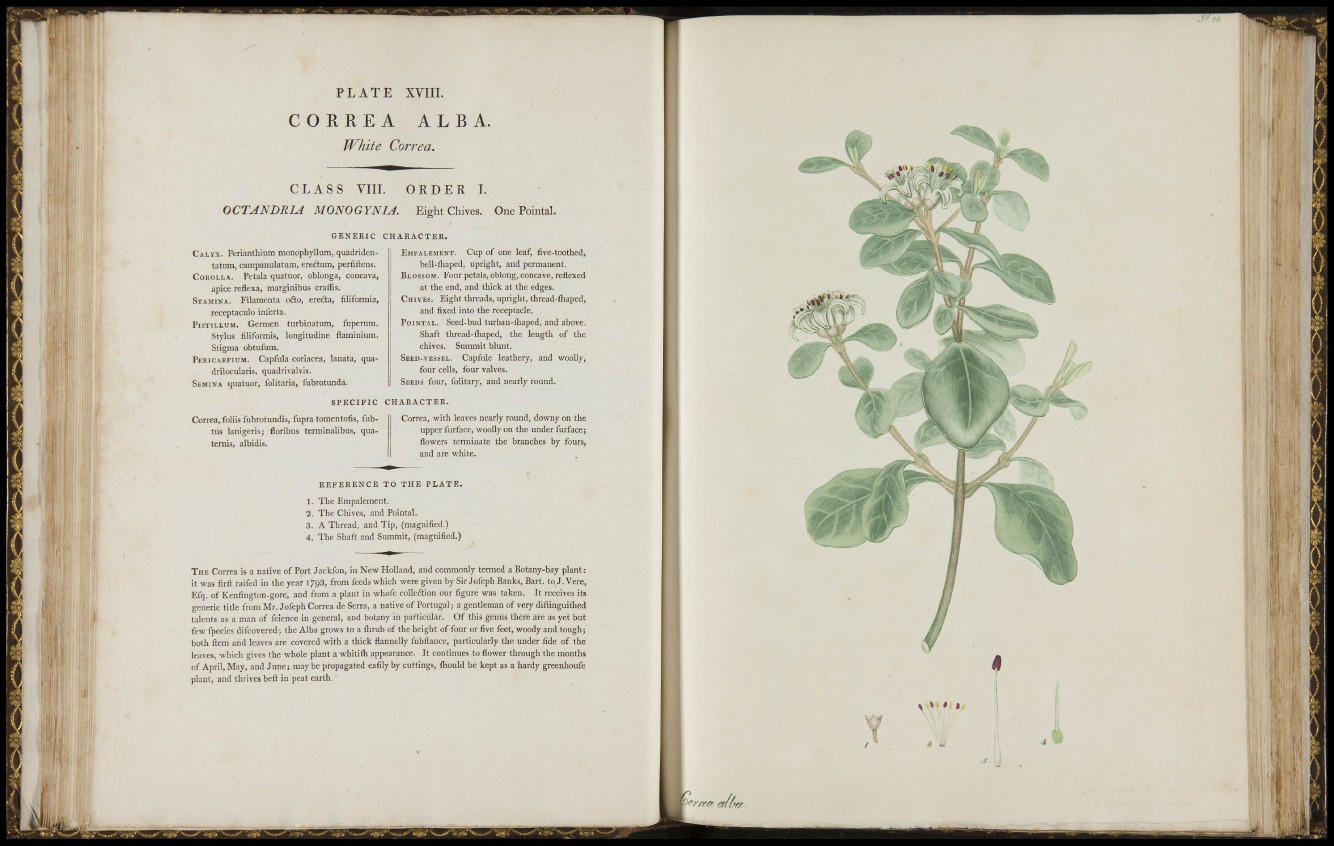
i
P L A T E XVIII.
C O R R E A ALBA.
White Correa.
C L A S S Vili. O R D E R I.
OCTANDRIA MONOGYNIA. Eight Chives. One Pointai.
G E N E R I C CHARACTER.
CALYX. Perianthium monophyllum, quadridentatum,
campanulatum, ereñum, perfiftens.
COROLLA. Pétala quatuor, oblonga, concava,
apice reflexa, marginibus craffis.
STAMINA. Filamenta ofto, creda, filiformia,
receptáculo inlerta.
PisTiLLUM. Germen turbinatum, fupernra.
Stylus filiformis, longitudine ftaminium.
Stigma obtufum.
P E R I C A E P I U M . Capfula coriacea, lanata, quadrilocularis,
quadrivalvis.
SEMINA quatuor, folitaria, fubrotunda.
EMPALEMENT. Cup of one leaf, five-toothed,
bell-lliaped, upright, and permanent.
BLOSSOM. Four petals, oblong, concave, reflexed
at the end, and thick at the edges.
C H I V E S . Eight threads, upright, tliread-fliaped,
and fixed into the receptacle.
PoiNTAL. Seed-bud turban-tliaped, and above.
Shaft thread-fliaped, the length of the
chives. Summit blunt.
SEED-VESSEL. Capfule leathery, and woolly,
four cells, four valves.
SEEDS four, folitary, and nearly round.
S P E C I F I C CHARACTER.
Correa, foliis fubrotundis, fupra tomentofis, fiibtus
lanigeris; floribus terminalibus, quaternis,
albidis.
Correa, with leaves nearly round, downy on the
upper farface, woolly on the under furface;
fiower.s terminate the branches by fours,
and are white.
R E F E R E N C E TO THE PLATE.
1. The Empalement.
1. The Chives, and Pointal.
3. A Thread, and Tip, (magnified.)
4. The Shaft and Summit, (magnified.)
THE Correa is a native of Port Jackfon, in New Holland, and commonly termed a Botany-bay plant:
it was firft raifed in the year 1703, from feeds which were given by Sir Jofeph Banks, Bart, to J . Vere,
Efq. of Kenfington-gore, and from a plant in whofe colleftion our figure was taken. It receives its
generic title from Mr. Jofeph Correa de Serra, a native of Portugal; a gentleman of very diftinguifiied
talents as a man of fcience in general, and botany in particular. Of this genus there are as yet but
few fpecies difcovered; the Alba grows to a ilirub of the height of four or five feet, woody and tough;
both ftem and leaves are covered with a thick flannelly fubftance, particularly the under fide of the
leaves, which gives the whole plant a whitilh appearance. It continues to flower through the months
of April, May, and June; may be propagated eafily by cuttings, ihould be kept as a hardy greenhoufe
plant, and thrives beft in peat earth.
1
'Sf
2 4
rr/iw
.-^'tJ.T"'''- - . . . , • • - - ~ -
!l 'Vf
: ir . ,r
r ' f i,. '
•• Î1 •• ^
' i ' " " il
'.H
ii -.IT
II.
•M
m.